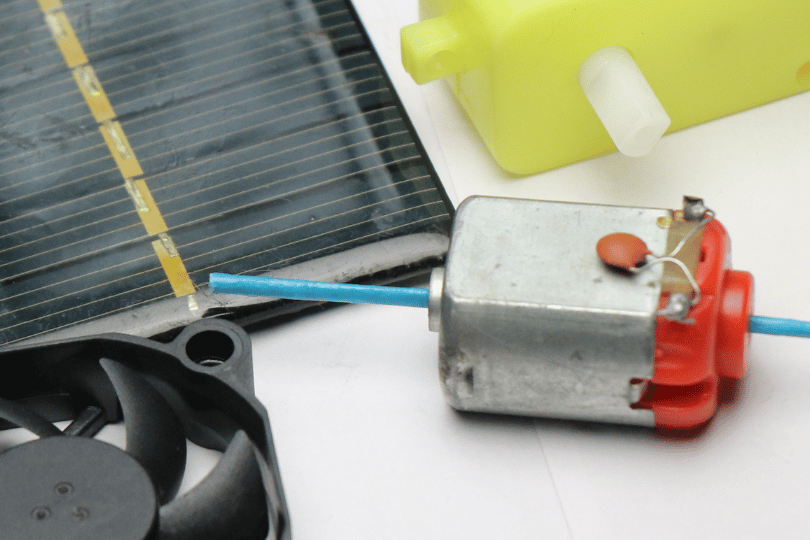Why a small capacitor is connected across DC motor terminals?
Have you ever noticed that small, flat, disc-like component soldered to the two wires coming out of the motor in your toy car, robot, or other hobby electronics? That unassuming little thing is called a capacitor, and it plays a crucial role in the smooth operation and lifespan of the motor.

The capacitor connected across the terminals of a DC motor is typically a ceramic disc or metal film type. This capacitor is often referred to as a bypass capacitor or a snubber capacitor.
The primary reason for using a capacitor across the terminals of a DC motor is to suppress or ‘snub’ electrical noise generated by the motor. When a DC motor operates, it inherently produces electrical noise or electromagnetic interference (EMI) due to the commutation process (the switching of current direction) within the motor. This EMI can interfere with other electronic components in the circuit, causing them to malfunction or perform unpredictably.
By placing a capacitor across the motor terminals, the EMI produced by the motor is shunted through the capacitor, effectively ‘bypassing’ the rest of the circuit by providing a low-impedance path. This action significantly reduces the amount of noise that reaches other components, ensuring the stable and reliable operation of the entire system.
- Taming the Spark: As the brushes in the motor make contact with the commutator to switch the current and keep the motor turning, tiny sparks fly. These sparks create electrical noise and voltage spikes that can damage the motor itself and interfere with nearby electronics. The capacitor acts like a tiny sponge, soaking up those excess electrical charges and smoothing out the current flow. This reduces the electrical noise, protecting the motor and any sensitive circuits nearby.
- Smoother Spins: A capacitor in a DC motor smoothens voltage fluctuations by storing and releasing electrical energy, ensuring a more consistent power supply for improved motor performance. A smoother current flow also means the motor runs more efficiently and delivers smoother rotations, making your toy car zoom or your robot dance with greater precision.
- Shielding from Surges: When the motor stops, it can generate a voltage surge in the opposite direction called back EMF. The capacitor absorbs this surge, protecting the motor’s driver circuits from getting fried.
- Keeping it Clean: The electrical noise from the motor can disrupt radio signals and other electronic devices. The capacitor acts like a filter, blocking these unwanted emissions and keeping the electromagnetic environment tidy.
Additionally,
- The value of the bypass capacitor used can vary depending on the specific motor and application. It is typically chosen to provide optimal noise suppression for the frequency of noise generated by the motor.
- While bypass capacitors are highly effective at reducing EMI, they are not a substitute for good circuit design. Other methods, such as proper grounding techniques and the use of EMI filters, should also be employed to minimize EMI in electronic systems.
Applications
Bypass capacitors are used across DC motor terminals in a wide range of applications. These include, but are not limited to:
- Consumer Electronics: Devices such as printers, scanners, and DVD players use DC motors for various functions. The capacitors ensure these devices operate without electronic interference.
- Automotive Systems: DC motors are used extensively in vehicles for functions like adjusting mirrors or moving power windows. The capacitors help prevent interference with the vehicle’s electronic systems.
- Industrial Machinery: Many industrial machines use DC motors for movement and operation. The capacitors ensure the reliable functioning of these machines by reducing EMI.
Next time when you see, that small capacitor connected across the terminals of a DC motor plays a crucial role in ensuring the reliable and stable operation of electronic systems. By effectively suppressing the electrical noise generated by the motor, it allows other components in the system to function as intended, highlighting the importance of this often-overlooked component.